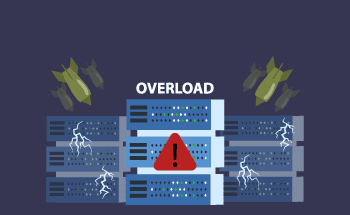Hosting with a test period: what it is and why you may need it
10:59, 09.12.2021
The test period - the possibility of short-term rental server at no charge. This is a good opportunity to assess the quality of services provided by a hosting provider. If there are no problems during the trial period, it proves that the hosting provider is responsible and open to the clients. In this article, we are going to tell you what aspects you should check during the trial period and what you should focus on during the analysis.
Checking the stability of the connection
Constant connection to the Internet does not mean that the connection from the hosting provider is stable. On some nodes may occur significant packet loss data, and the work of the server is unacceptable. You can use special tools and built-in utilities to estimate the number of packet losses and trace short-term speed drops. Here are three main such tools for Linux distributions:
- Ping. This utility allows you to evaluate the health of a host by sending ICMP packets. If you enter this command without additional parameters, the ping of the specified host will be looped and will be infinite. If you want to send, for example, 5 requests in a row, you have to add to the command the -c. You can also set the size of packets to be sent in bytes. For example, by writing the -s 2000 parameter, you will set the packet size to 2000 bytes.
- Traceroute. This command uses UDP packets, and by default three data packets are sent at once, and the program measures the transit time. The traceroute utility allows to define of data traces in TCP/IP networks, it has many options available which can be used to adjust the test parameters.
- Mtr. Quite a good alternative to the previous one, which allows you to poll the server continuously for a long time, monitoring the latency and stability of the connection. It has a fairly simple syntax that even a novice can easily master.
It is important to check the stability of your connection to make sure that you should continue to work with one provider or another. Our website has a separate Looking Glass tool for this purpose, which you can use by clicking here. And if any critical problems arise during the trial period, you should move on to other available options.
Checking page load speed
If renting a VPS is carried out to accommodate one or more sites, the speed of loading pages has the highest priority. In the 21st century, people are used to huge dynamics, and no one likes glitchy sites that load more than 2-4 seconds. If the speed of loading pages on your site is above comfortable values, there is a risk that you will constantly be losing visitors - people will simply close the page before it has time to load.
The second point - loading speed is a significant factor in ranking websites by search engines. The faster the loading site, the higher the probability that it will take the top lines in search results.
There are many different services for checking page load speed, and here are the three most popular:
- Google PageSpeed Insights. The official tool developed by Google. It is most often used by SEO-specialists and webmasters when working, because it has a user-friendly interface, works steadily, and provides quite detailed information. First content load time, load speed index, CPU end time, and other important analytical data. The cherry on the cake will be the optimization tips that the system automatically gives based on the analysis.
- Pingdom Tools is an advanced tool that uses about a hundred global factors in its analysis. It will also help you estimate your site's loading speed and provide useful tips on how to fix the flaws.
- Uptrends.com. A free service that offers the ability to assess page loading speeds both on the desktop and for mobile devices - smartphones, tablets, etc. Before the analysis, you can change many parameters, from display resolution to browser selection. Detailed analysis is presented to the user in the form of detailed tables and graphs.
There are dozens of such tools, so you do not have to use the ones we offer. In any case, during the trial period when renting a VDS, you should thoroughly check the speed of page loading to see if the provider's servers can handle the load.
Checking Server Stability
Fault tolerance is one of the main indicators of server quality - it is the so-called Uptime. A good hosting provider is able to minimize the number of operational errors and provide uninterrupted work of the clients' websites round-the-clock.
Uptime is possible to reach 100% only in the most ideal and sterile conditions, but in reality, everybody tries to reach 99,9% fail-safe performance. It is an achievable and realistic figure on the condition of the competent organization of the network infrastructure, but it is necessary to understand that high Uptime depends not only on the hosting provider but also on the clients themselves. Here are the factors that may have a negative impact on fault tolerance:
- Increase in traffic. A natural and positive factor is that as traffic increases, the load on the site increases, and at the same time the stability decreases. For this reason, it is necessary to scale capacity in a timely manner so that your server is ready for such loads.
- Active scanning of the site by robots. If the site pages, search engines will analyze and index them, which may also affect the stability. This also includes various bots. To minimize the impact of robots on the stability of the server, you need to properly configure access to site pages and documents through the robots.txt file.
- Incorrect operation of the scripts. Irrelevant or incorrect scripts can significantly reduce the stability of the VPS due to the occurrence of conflicts.
- DDoS-attacks. Targeted attacks on the site are one of the reasons for a sharp drop in uptime. DDoS protection, among other things, depends on the experience and knowledge of the system administrator of your server.
The test period is quite capable of setting up all these aspects in a short period of time and performing thorough stability testing. There are many free tools available for real-time load testing - for example, Jmeter, developed by the Apache Software Foundation. The tool now offers a lot of advanced features and functions and can be used to audit JDBC connections, FTP, LDAP, SOAP, JMS, POP3, IMAP, HTTP, and TCP.
Availability of technical support
If the client has any difficulties with the configuration or maintenance of the servers, it is important that the hosting provider has experts who can help to sort out any issues. HostZealot offers a 24/7 support service that allows you to speak to our specialist in English or Russian.
The responsiveness to our customers' questions should also be checked - this will allow you to understand how quickly the problems can be resolved in a real "live" environment.
FAQ section
The FAQ section is necessary so that the client himself can get the necessary information on any questions. This section should contain detailed answers to the most common issues that people face when renting VPS and VDS. However, if there is round-the-clock technical support, this point can be neglected - it is more convenient and productive to communicate with a live expert in any case than to delve into dozens of sub-items FAQ.
Conclusion
The trial period will be useful for newbies who are facing the need to rent virtual servers for the first time and still have a bad idea of which hosting provider is the best to apply to. If you have any questions - leave an application on the site or call us, all contacts are presented in the appropriate section.


